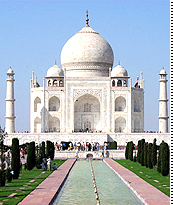|
||||||
|
|||||||
|
Book Online travel india, the land offering diverse travel opportunities, ranging from travelling through the himalayas to the kanyakumari. taj mahal, khajuraho, goa and kerala backwaters are some favourite rendezvous for travelling in india. opt for cultural, heritage or an adventure travel of india and make your travel experience in india a lifelong memory. |
Home :: India
Advanture Tour :: Mountain Climbing India
Mountain Climbing in LadakhThe area most frequented by foreign climbers is the Nun-Kun Massif in the Great Himalayan Range. Its easy accessibility from the Kargil-Pudum road and the shortest possible approach march to the base camps makes this massif the most attractive climbing destination in the Great Himalayas, necessitating advance booking years ahead. Among its six known peaks accessible from the Suru Valley, Nun (7,135m) and Kun (7,077m) are the highest summits. The area nearest to Leh is Stok-khangri Massif in the Zanskar mountains, south of Leh. The base camp for the various peaks of this massif is about two days trek from the village of Stok. Among its known peaks, Stok-khangri (6,150 m) is the highest; it offers a spectacular perspective to the central expanse of the Indus valley, which it dominates. Other peaks in the Ladakh area include Gulap Khangri (5,900 m), Matho West (5,950m) and Kantak (5,275 m). The much higher Konglacha peak (6,700m) lies southwest of Leh and is reached via Rubak on the first leg of the Markha Valley trek from Stok. Many un-named peaks in the altitude range of 5,500 metres and 6,400 metres are also available for climbing in the same region. This entire area falls well outside the Inner Line, or restricted area. North of Leh, across the Ladakh Range and the Nubra Valley, lies the Karokoram range. It soars to a number of known peaks which are, however, within the restricted area and so not freely accessible to foreign climbers except with special permission from the Government of India. The most prominent summits in this range which are accessible from various parts of the Nubra Valley include, Saser-I (7,415 m), Saser -II (7,513m) and Saser III (7,495 m). The climbing season extends from mid - May to mid -October, the ideal period being from June to September because during this time only Ladakh remains unaffected by the monsoon which holds sway over most of the Himalaya. Foreign climbing expeditions are required to obtain permission from the Indian Mountaineering Foundation for climbing all listed peaks. A booking fee, based on the height and popularity of the allotted peak, is charged and a Liaison Officer is assigned to every climbing team. The minimum period required for processing applications is six months. Every authorized expedition is provided with adequate rescue coverage in the events of accidents and illness. Mountaineering is the ultimate challenge, the trial by fire, for the spirit, the mind and body. Striving to reach for the pinnacle, is essentially an urge to reach within, to discover the essence of one's being. Ladakh The land of rugged rocks and serrated glaciers, Ladakh offers a challenge to mountaineers that not many can resist. The Susu and Zanskar Valleys are adorned with a number of spectacular mountain peaks that attract climbers from the world over. In particular, the Nun-Kun massif serves as the focus of increasing mountaineering activities in the region. Its easy accessibility by road and shortest possible approach march to reach the base camps makes the Nun-Kun massif one of the most attractive mountaineering destinations in the Western Himalaya. Nearby is the Zanskar massif with several challenging peaks surrounding the majestic Drang-Drung Glacier, adjoining Penzi-La. This massif too is accessible by road up to the base of the glacier and the approach trek to the base camp is at a day's trek from the road. The Zanskar Group The Zanskar massif lies adjacent to the Nun-Kun massif. Most frequented area in this group is along the Drung-Drung Glacier below Penzi-La, on the Kargil Zanskar road. Its base camp can be approached in a day's trek from the road head. The best known peaks in the group are Z-2 (6175m), Z-3(3270m) and Z-8 (6050m). In addition there are many unnamed peaks in the area in the altitude range of 5000m to 6000mt. The climbing period in the region extends from early June to mid October, the main climbing period being June-August when most of the Himalayas remain inaccessible due to the monsoon elsewhere. The Ladakh Himalaya however remains unaffected. Central Himalayas The ranges of the Great Himalayas- Zanskar, Pir Panjal (or Shivalik) and Dhauladhar provide the State its mountainous character. The main peaks of this region include, Leo Pargil (6791m) above sea level, Kinner Kailash (6050m) with Jorkaden(6473m) to the immediate south and Raldang(5499m) and Phawarang (6439m).The twin peaks of Gushu(5607m) and Pishu(5672m) are situated between Sarahan and Pin-Parbati Pass. |
 |
Destinations in India
|
Holidays in India
|
India Tour Packages
|
||